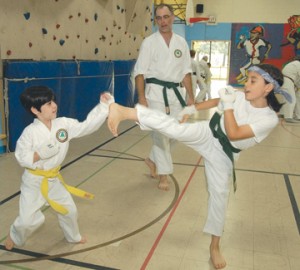
It’s not about fighting others but about making yourself the kind of person you want to be, says sensei
It’s hard to separate legend from the real story, Sensei Burt Konzak tells his students before beginning his tale about the life of a samurai, both the protector and scholar of ancient Japanese life.
He stands before his class, slashing with an invisible blade, recounting the days of Bokudan and his ability of foresight.
All eyes are on the sensei. Students of varying belts, ages, genders and backgrounds eagerly wait for the moral of the story, which explains what it means to be a great karate-do follower.
For 10-year-old Robert Faraday trying to figure out the moral is one of his favourite parts of the class.
The green belt sits with his brother Alexander, 7, and his father Jim Lebans, 42. Their mother, who also comes to class, is absent this day.
“The (Zen) philosophy is really interesting,” Robert says. “Sometimes you read stories and they always have a moral that’s really hard to figure out.”
Robert’s father shares his interest, but is more interested in the sporting aspects of karate.
“Robbie has been learning a little about the philosophy around (karate), and his mother does a lot of yoga,” Lebans says. “I always joked with his mother that I liked the idea of yoga, as long as it was competitive and kept score.
“And karate is a little bit more like that, but of course the more you learn about it, the more it actually is like yoga.”
On the day of the class, Konzak’s tale is, coincidentally enough, about family and making the right decisions in life.
His allegory is vital to the class.
“We’re emphasizing to them that you can’t do (karate) if you can’t concentrate,” the former University of Toronto Japanese studies professor says. “Also, we’re teaching them that martial arts isn’t all about punching, kicking and self-defence: it’s about fighting, but not fighting other people.
“Most importantly, it’s about conquering yourself, making yourself the type of person you want to be.”
For most who enter martial arts, the first dream is to accomplish the black belt. But, Konzak says, after continual dedication the belt shouldn’t matter.
“There’s an expression in karate: ‘The highest level is not the black belt, but the white belt’, because it’s the beginner’s eyes that are so important in martial arts,” he says. “When a beginner sees a class for the first time, that enthusiasm is something we want to maintain.
“Over the years, people may get a little bit blasé about their training, they may lose their edge,” he adds. “The irony is when you get your black belt, the more you wear it. As you tie the belt and tie the belt, the fabric begins to wear away and it turns white.”
Through dedication to the art, students grow and mature in ways beyond their ability to fight.
“One of the things we are always teaching the class is martial arts is about strength and self-defence, but also about developing strength, not to beat up others, but your strength becomes the foundation of your character,” Konzak says.
Eric Miller, founder and instructor at the Mixed Martial Arts Athletic Club, agrees.
Miller emphasizes no contact in his mixed martial arts classes for kids. However, he isn’t as regimented when training them in Brazilian jiu-jitsu, muay thai and boxing.
“Everything is too stiff upper lip, stand straight, listen to me, don’t try things,” he says of individual arts classes. “For kids, (mixed martial arts) is just a positive environment.”
In a few weeks kids gain confidence and perform tasks they’d never thought they’d be able to.
And the kids are going to have a better understanding of what fighting is about and greater respect for each other, Miller says.
“When a kid touches a hot stove, he knows it burns,” he adds. “If it is all over the media and the kid has never actually seen it in a structured format, they’re going to want to do it in the backyard.”
Both Konzak and Miller agree violence through respect benefits everyone.
“A really great martial artist is able to handle a situation of violence and turn it into a win-win situation,” Konzak says. “You can do all sorts of techniques that aren’t going to involve hurting a person and communicate, ‘I don’t want to fight, but I can defend myself if it is necessary.’
“When you turn the situation away from violence, you haven’t made an enemy and if the guy is intelligent, he’ll realize he owes you something. You could’ve done him harm but you didn’t.”
